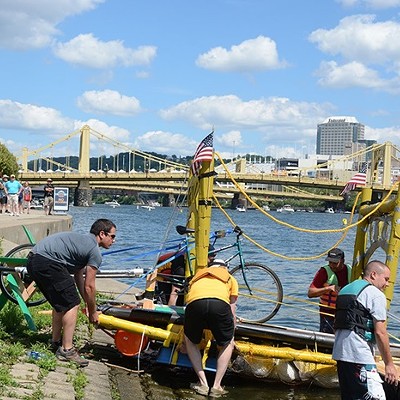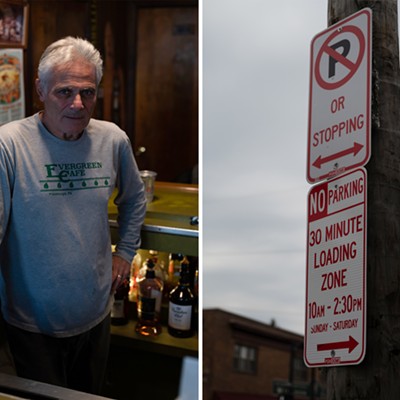In the debate about how to handle stormwater runoff — which fouls our rivers, causes flooding, and will likely get worse in coming years — Pittsburgh has reached a milestone. This January, for the first time in recorded history, nobody complained when we slowed up before a tunnel.
ALCOSAN, the agency that oversees stormwater from sewers in 83 municipalities, is under a federal order to prevent sewage from being dumped into the rivers, something that happens when heavy rainfall overwhelms our aging sewer system. ALCOSAN's initial solution was to dig giant underground storage tunnels to hold the excess water — at a cost of $3.6 billion. But environmentalists and social activists recommend a greener approach. Instead of laying more pipe, they ask, why not prevent water from reaching the pipes at all? Why not plant "rain gardens" to soak up water? Or encourage homeowners to install rain barrels? Or convince parking-lot operators to use permeable pavement, which allows water to sink into the underlying soil rather than flowing into sewer grates?
ALCOSAN is willing to listen, at least. In January, it asked the federal government for an additional 18 months to ponder such approaches. "We need to study the potential for green infrastructure," a spokesman explained.
"We were excited they requested the extension," says Jennifer Rafanan Kennedy of the Clean Rivers Campaign, an umbrella group for those pursuing a greener approach. "We think that's a win." And even if ALCOSAN doesn't embrace green solutions, she says, the city of Pittsburgh can, and should, undertake them on its own. Because those sewer fixes have benefits above ground too.
Planting more trees, for example, captures water while providing shade, which is often at a premium during a hot city summer. And from Philadelphia to Portland, other cities are reaping other benefits, too. In Cleveland, officials plan to convert vacant lots into ponds and gardens, trapping water while beautifying blighted neighborhoods. As the federal Environmental Protection Agency said in a 2012 statement, it's "a good way of comprehensively addressing social equity, economic stabilization and environmental quality simultaneously."
A key question, of course, is how the Pittsburgh Water & Sewer Authority — which has its hands full just dealing with aging water lines — would pay for this stuff. One likely answer is a new fee, often called a "stormwater utility."
Pittsburgh City Councilor Patrick Dowd, who sits on the PWSA board, says the agency is pondering such a fee. But Dowd hopes the authority will also offer discounts for property owners who adopt green approaches, like installing rain barrels or using permeable pavement.
"I don't want to charge people for stormwater," says Dowd. "I want to reward them for keeping it out of the system."
The need to do so will only become more pressing: Climatologists expect that one symptom of global warming will be more frequent severe storms, which will stress sewer systems further. But as the PWSA considers asking more of us, Dowd says, it can also address its own contribution to climate change — by finding a renewable source for the $5 million a year it spends on electricity.
In a 2008 study, the "Pittsburgh Greenhouse Gas Emissions Inventory," the Green Building Alliance found that treating and pumping drinking water accounted for 25 percent of local government's greenhouse-gas emissions. If only there were some renewable energy source the PWSA could draw upon, like a nearby dam ...
Wait a minute, there is. The PWSA's Aspinwall water-treatment facility is located a stone's throw from Allegheny River Lock and Dam #2. Why not harness it for hydroelectric power?
"That's not a new idea," says Don Waldorf, the PWSA's deputy director of engineering and construction. "We had it back in the 1990s, and we're re-exploring it because it's an excellent idea — you've got all this energy cascading over the dam." There are a number of challenges, though, the biggest of which is cost: Installing turbines and other equipment would cost well over $100 million. "You can buy a hell of a lot of electricity for that," Waldorf says.
The dam "is an excellent source of green power," Waldorf says. "But like all green power it's elusive because of the upfront cost."
Editor's note: An earlier version of this story misleadingly stated ALCOSAN's responsibility for the region's sewage system.














